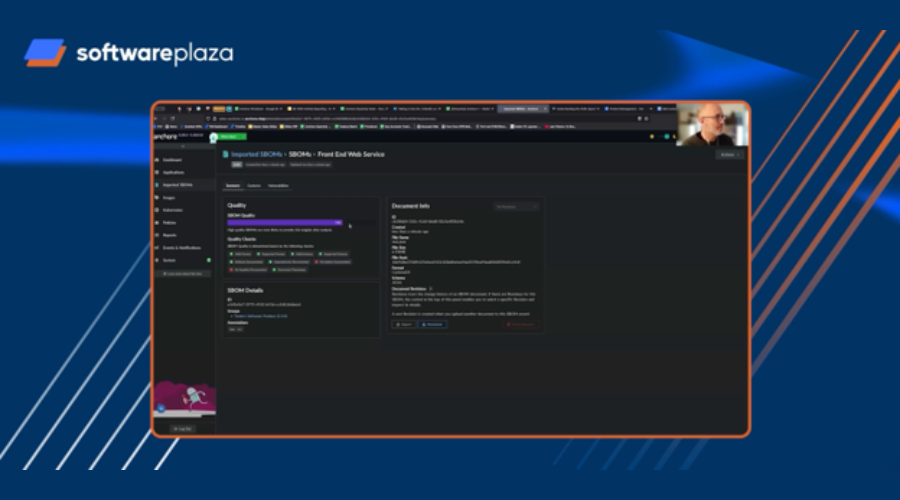Software Bill of Materials (SBOMs) have rapidly evolved from niche documentation to a pivotal asset in software supply chain security. Initially viewed as compliance artifacts, SBOMs are now essential in detecting vulnerabilities, managing risk, and maintaining trust with customers and regulators. Anchore, a leader in SBOM generation and analysis, is at the forefront of this shift.
This blog post focuses on how Anchore shows exactly how SBOMs can deliver real security value, not just satisfy regulations.
From Compliance Necessity to Strategic Asset
For years, SBOMs were a behind-the-scenes architectural element in secure software delivery. Anchore itself began by producing “analysis artifacts” for containers, essentially SBOMs in everything but name, to help developers and security teams understand what was inside their builds.
The landscape changed dramatically as high-profile open-source supply chain attacks (such as SolarWinds and Log4j) exposed the need for deeper visibility. This was reinforced by regulatory actions like:
- EU Cyber Resilience Act (CRA): Mandating SBOMs for all products with digital elements, with an emphasis on security traceability.
- U.S. Executive Orders & DoD Requirements: Driving SBOM adoption for government-supplied software.
What was once a “cloud-native best practice” is now a cross-industry mandate. Today, whether you’re a SaaS startup, an automotive OEM, or a medical device manufacturer, SBOM management is part of your operational reality.
The New SBOM Challenges
As SBOM adoption has spread, so have its operational hurdles. Anchore identifies three recurring issues that slow teams down:
1. SBOM Quality and Fidelity
Generating an SBOM sounds simple until you face software stacks with proprietary binaries, embedded firmware, or missing metadata. While modern cloud software is relatively easy to scan, embedded systems often lack open tooling, leading to incomplete or inconsistent SBOMs. This affects vulnerability detection accuracy and compliance readiness.
2. SBOM Sprawl
A large enterprise may have thousands of SBOMs across multiple products, teams, and suppliers. Coordinating generation, storage, and updates is a logistical challenge, especially when different groups use different tools and formats. The result: fragmented visibility and difficulty producing a “single source of truth” for customers or regulators.
3. Proving Security Value
Security leaders want SBOMs to go beyond “checkbox compliance” and actively improve posture. But if SBOM data is noisy, incomplete, or outdated, it can trigger false positives and overwhelm teams. Without clear prioritization, time and resources are wasted on issues that matter less.
Anchore’s Vision: SBOM Management for Security Outcomes
Anchore’s latest release is designed to address these challenges head-on. While earlier products focused on generating SBOMs from Anchore’s own tools, the new features reflect a reality where organizations get SBOMs from multiple sources and need a central intelligence layer to make them useful.
1. Bring Your Own SBOM
This feature lets users import SBOMs from any compliant source, such as vendors or partners, in SPDX or CycloneDX formats. Once imported, SBOMs can be grouped to represent complete applications, devices, or services, whether they were generated by Anchore or not.
Why it matters:
- Unifies SBOMs from across your ecosystem into one management platform.
- Enables downstream security analysis even when you don’t control the generation process.
- Highlights gaps or missing fields like authors or supplier info to push back on low-quality submissions.
2. Anchore Rank
Anchore Rank is an intelligent scoring system that prioritizes vulnerabilities by combining multiple data sources:
- CVSS severity (traditional scoring)
- EPSS (likelihood of exploitation)
- Known Exploited Vulnerabilities (KEV) list
By factoring in exploitability and real-world activity, Anchore Rank directs teams toward issues that pose the greatest actual risk, not just the highest theoretical severity.
Why it matters:
- Cuts through noise by highlighting vulnerabilities most likely to be exploited.
- Avoids chasing “critical” CVEs that have low real-world impact.
- Sets the stage for customizable scoring in future releases.
3. SBOM Grouping and Export
Teams can combine multiple SBOMs into a single, consolidated artifact for distribution to customers, auditors, or partners. This supports real-world workflows. For example, a car manufacturer producing one SBOM that covers all embedded software in a vehicle.
Why it matters:
- Simplifies compliance reporting.
- Reduces manual stitching of SBOM data.
- Supports trust and transparency with downstream consumers.
Tackling SBOM Sprawl and Lifecycle Management
One of the thorniest issues in SBOM management is keeping them up to date as software evolves. Anchore’s position is clear: an SBOM should be tied immutably to a specific software version. If the software changes, you generate a new SBOM.
This avoids “drifting” SBOMs that no longer match the artifact they describe, though it means processes must ensure regeneration when updates occur. Anchore also flags where tools have improved their detection capabilities, prompting rescans when higher-fidelity SBOMs become possible.
Automation and Integration
Anchore recognizes that SBOM management must fit into automated pipelines, not manual checklists. Their platform integrates with CI/CD workflows, enabling SBOM generation at build, deploy, or runtime without developer intervention.
Automation also extends to:
- Vulnerability analysis as soon as SBOMs are ingested.
- Webhook and ticketing integrations for collaboration and alerting.
- Planned compliance report automation, pushing results to required endpoints with minimal human touch.
The Road Ahead: SBOM Insights and Beyond
Anchore’s roadmap includes expanding from vulnerability management into broader “SBOM insights.” By mining aggregated SBOM data, organizations could uncover:
- Version sprawl and outdated dependencies.
- Teams using lower-quality components compared to peers.
- Emerging risks are not yet linked to known vulnerabilities.
This predictive layer could turn SBOM repositories into early-warning systems for supply chain weaknesses, shifting security posture from reactive to proactive.
Why This Matters for Your Organization
If your SBOM process is still in “compliance mode,” you’re missing an opportunity. Anchore’s approach illustrates how SBOMs can:
- Enhance visibility across your software ecosystem.
- Improve prioritization of security work.
- Enable proactive vendor management by assessing SBOM quality.
- Simplify reporting for regulators and customers.
With features like Bring Your Own SBOM and Anchore Rank, you can integrate supplier-provided SBOMs into your security workflow, identify the vulnerabilities that matter most, and maintain an authoritative record of your product's software composition.
This blog is based on webinar Beyond Compliance: Neil Levine Reveals How Anchore is Revolutionizing SBOM Management With Neil Levine, SVP of Products at Anchore. To watch the video, click here.
SBOMs aren’t just paperwork; they’re a map of your software’s DNA. With the right management and analysis, they become a powerful weapon against supply chain threats. Anchore’s latest release shows that when you centralize, standardize, and enrich SBOM data, you can transform a compliance obligation into a strategic advantage.






